Comparing NanoVNA with the Keysight Fieldfox N9952A

Vector network analysers (VNA) come in all sort of price ranges. Most of them are out of reach for a typical hobbyist. Very few VNAs are available to be bought by someone like you and me. For example, the $500 miniVNA and the sub-hundred dollar nanoVNA are very much affordable in comparison to the thousands of dollar equipment available out there. In this post, we will be looking at the two EXTREMES available in the market today; the sub-hundred dollar nanoVNA and the Keysight fieldfox N9952A.

The Keysight Fieldfox N9952A can operate over 300kHz to whopping 50GHz. It offers a dynamic range of 70 to 100dB and comes with plenty of features such as Time domain reflectometry, adjustable output power, adjustable IF bandwidth, and so on. In short, the N9952A has everything a professional RF design engineer requires. Additionally, this device can also operate as a Spectrum Analyzer mode to observe the frequency spectrum. Let us get to the comparison real quick. In this article, we will be testing a a low pass filter and an antenna and then comparing the measurement results from both the instruments.
Calibration test
Calibration is the first step before you even begin to use your VNA. To do so, we will use respective calibration kits that come with the two devices. In the case of the Keysight VNA, we will be using the 85561A 2.92mm 4 in 1 calibration kit. Whereas, the individual open-short-load will calibrate the nanoVNA.
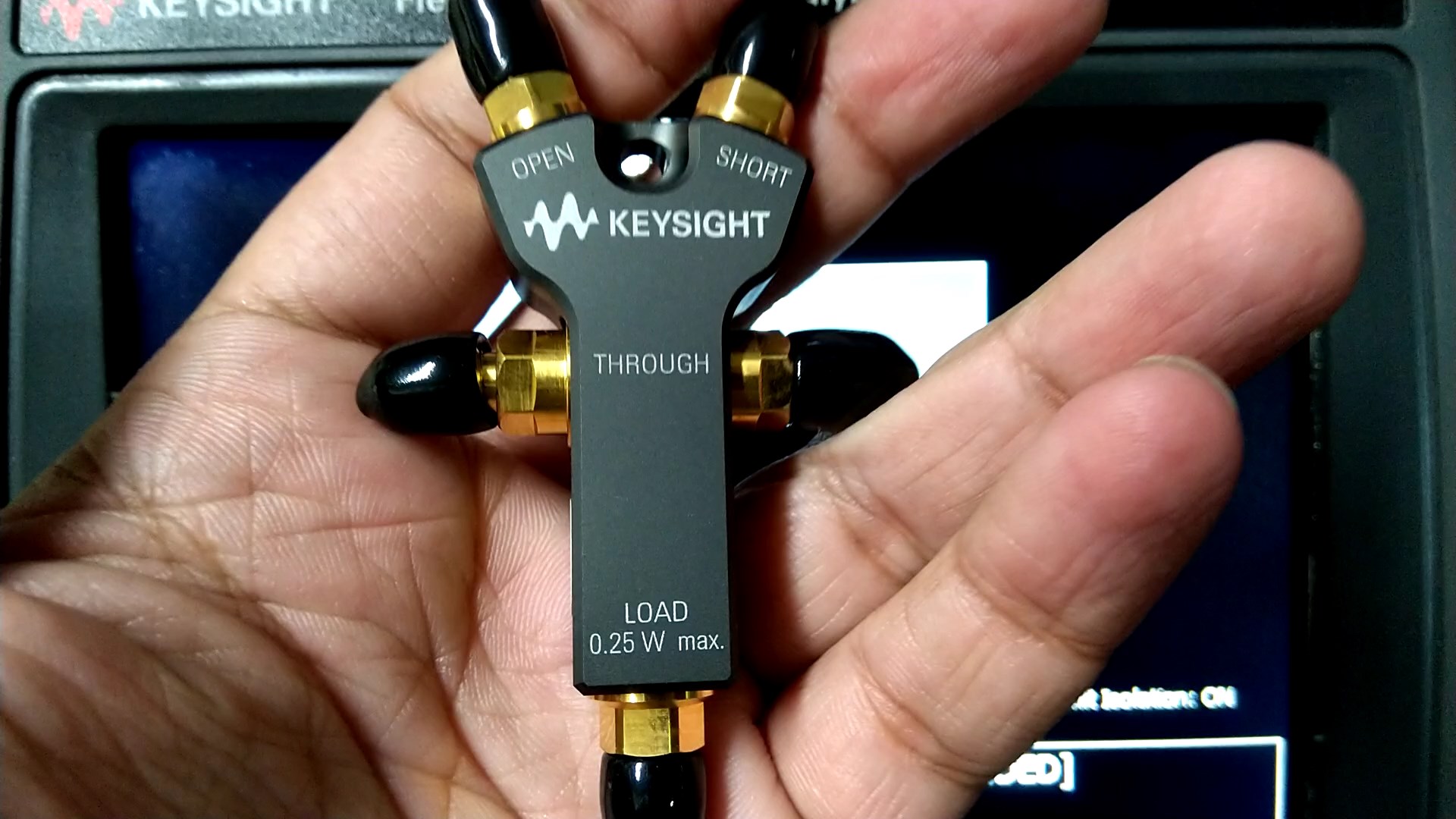
I made sure that the devices were warmed up for at least 15 minutes prior to calibration. Furthermore, the calibration process takes approximately five to ten minutes. Once calibrated, the ideal return loss response should be a flat line indicating 0dB across the frequency span of interest. Let us find out how our VNAs performed in this test.
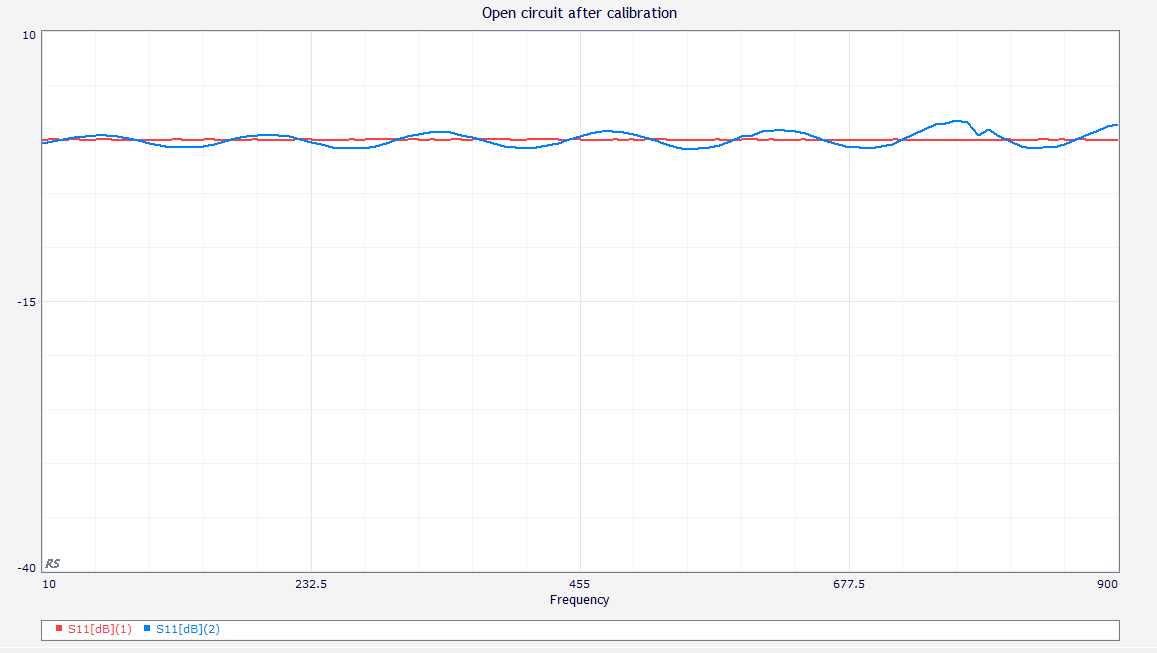
Red line: Keysight VNA
Blue line: NanoVNA
After calibration, the Port 1 of the VNA was left open. Obviously, the Keysight VNA shows a flat line whereas, nanoVNA seems to be struggling with ringing in the return loss plot. It appears that the nanoVNA may not handle full span calibration very well. Therefore, I further try reducing the span and calibrating it again. Let us look at the calibration done for 10MHz to 500MHz span.
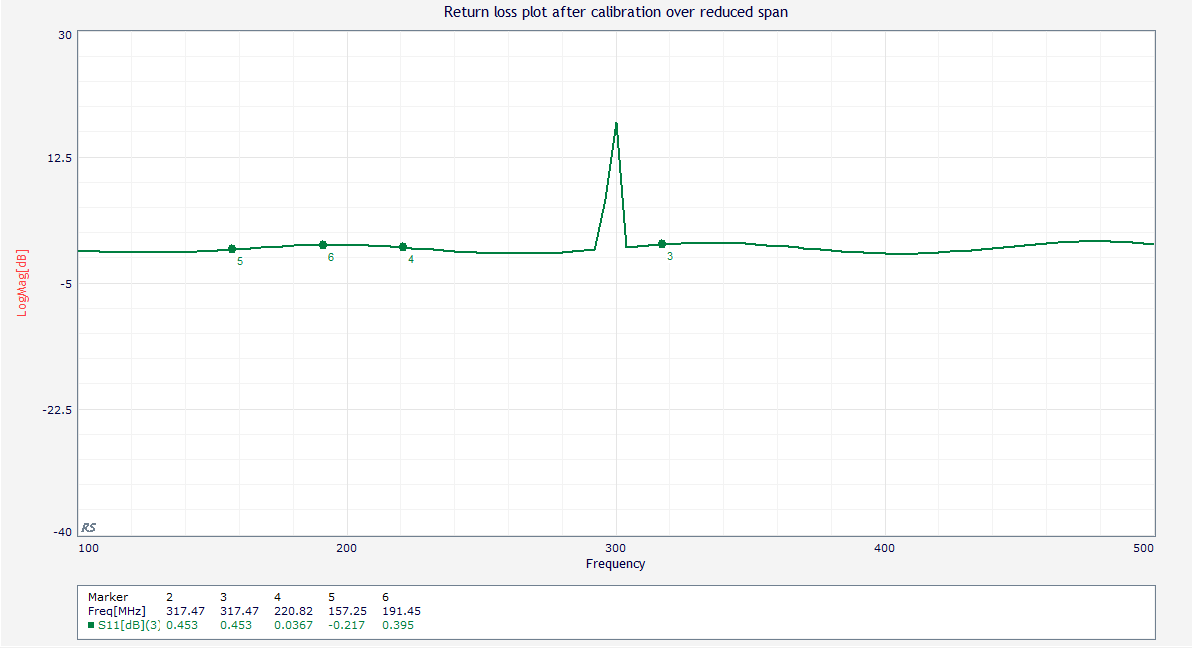
Even after reducing the span, we still see the ringing while keeping the port open-circuited. Furthermore, a constantly varying spike also appears at 300MHz. Looking at the circuit of the nanoVNA, we come to know that the stimulus generator works only up to 300MHz. Beyond 300MHz, it uses the harmonics for calculating S-parameters. As a result, we see reduced dynamic range above 300MHz. Nevertheless, the readings are still good which we will see further in this blog post.
Looking at the graph carefully, we see a return loss error in the range of 0.5dB to 0.7dB. For a hobbyist, this error is negligible. You can’t complain about this kind of error for the price you are paying. In my view, nanoVNA PASSES the calibration test.
In order to obtain a very good calibration, I reduce the span further in the range of 100MHz to 200MHz and only then do I see a very flat graph.

As you can see the problem lies only in very large spans. The operation is flawless when we bring the device in its comfort zone.
Testing a filter
Observing filter response can be an interesting thing to do on a VNA. I have a Minicircuits SLP-200 Low pass filter having a 200MHz cut off frequency. Let us observe its response on both the VNAs at once.


Red: Keysight VNA
Blue: NanoVNA
Return loss performance of the low pass filter on both the network analyzer looks absolutely close. An error of approximately 2dB exists in certain frequency regions. Nevertheless, nanoVNA being a low-cost device is able to give us a pretty fair idea about the filter performance. Huge thumbs up to the nanoVNA!
Now that we have observed the return loss, let us have a look at the insertion loss or the S21 measurement.

Red: Keysight VNA
Blue: NanoVNA
Keysight VNA definitely has a huge dynamic range and we are able to observe that in the cut of the region of the filter. On the other hand, the nanoVNA isn’t able to show true suppression characteristics of the filter. In my opinion, the nanoVNA works very well up to 300MHz and then takes a hit past that. Even so, the measurements are quite spot on.
1-port antenna reflection coefficient test

I connected a 400MHz antenna to both the devices and observed the performance.
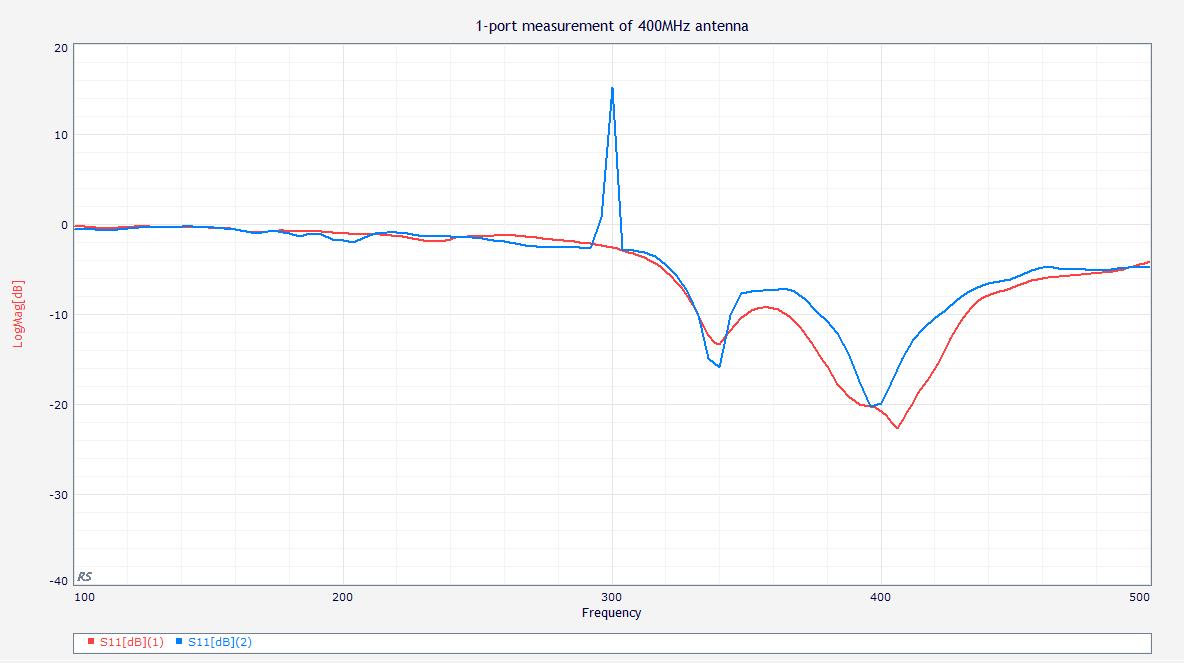
Red: Keysight VNA
Blue: nanoVNA
My previous concern appears to be coming true. The device performance starts to degrade past 300MHz. We can see a major difference between the two readings. Although, both measurements clearly show the antenna resonance point at 400MHz, the -10dB bandwidth does differ by several MHz.
Verdict
Apart from a few errors here and there, the nanoVNA appears to perform very well. As they say, “Something is better than nothing”. The nanoVNA is something to give us a rough idea about our antennas, be it RF filters or something else. There are many things that could improve in the nanoVNA circuit. For example, the Si5351 could be replaced with a better performing wide band PLL. The RF circuitry could be better shielded to improve the dynamic range and reduce high-frequency errors. The list goes on and with the list, so does the cost. We can’t have it all. So, we all have to settle somewhere and I prefer to settle with the $60 nanoVNA than a $50,000 FieldFox.

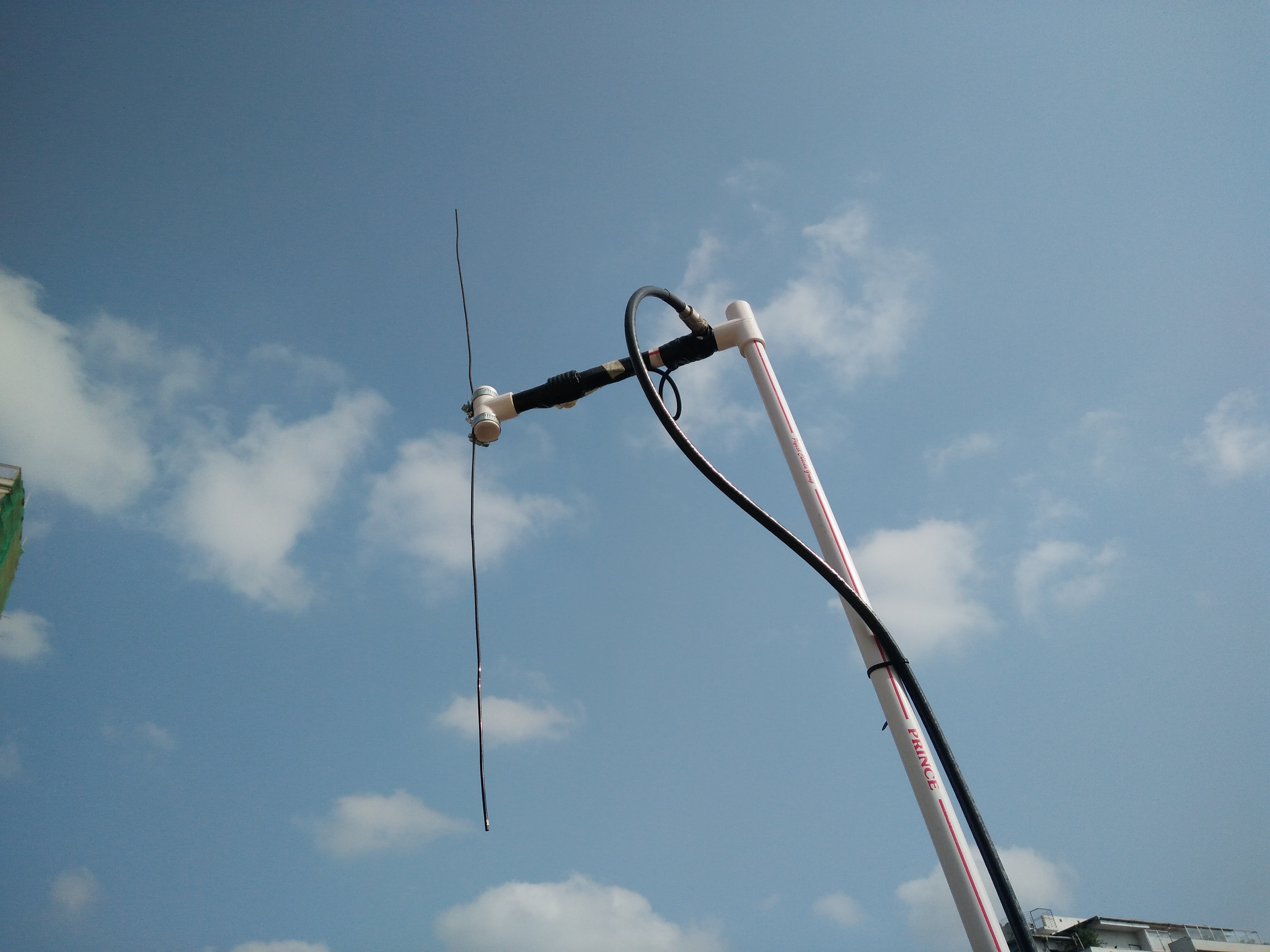


Jabardast ?
Thank you for these reviews. They help others in deciding on the purchase of the nano.
Cheers,
Vince
Your comment encourages me to write such posts more often.
Great stuff!
Waiting for one of these low cost VNA’s to arrive in order to adjust a 70cm transmit filter.
Very insightful article. Thanks.
Nice article. Thank you very much for that. You should visit https://groups.io/g/nanovna-users/topics and scan through the threads. The problem(s) you encountered have been experienced by other and fixes are available. They usually involve a different version of the firmware. Links to the FW and instructions are available there along with an enormous amount of additional information
Enjoy,
AE5CZ
Interesting to know that there are different versions of the firmware available. I was just wondering last night before sleeping that the beauty of this open-source device is that soon we will see better firmware coming out. It is crazy the new firmware is already out!!!
The response peaks you see at 300 MHz I believe may be caused by the nanovna’s SI5351 running out of range in the fundamental mode (<= 300 MHz) – the si53151 isn't rated that high, and is being overclocked (and uses 2nd harmonic beginning at 300 MHz, then 3rd harmonic beginning at 600 MHz). You may wish to look for the 800 MHz (max freq) version of nanovna firmware, and re-run your comparison once that's loaded. That runs the SI5351 up to 266 MHz before switching to 2nd harmonic then 533 MHz before switching to 3rd harmonic. Consult participants on nanovna-users@groups.io list for information on firmware and firmware update procedures.
Thanks Dave for your insight into the device operation. I will try to get myself into the group and check out the discussions there.
Its funny because the fieldfox is normally viewed as a lower cost low dynamic range device.
The fieldfox uses harmonics too to create the higher frequencies as it outputs a square wave.
The plots look pretty good,
The large error at 300MHz is quite alarming, must have a gap of coverage.
I really would have thought they would be able to get better amplitude performance >300MHz, looks like there is a systematic error there, for those differences of 2-3dB etc.
Fieldfox is indeed a lower cost device when you compare the benchtop beasts that can generate a very clean sinewave output throughout the instrument range. I have always loved the R&S instruments which in fact sell at a much higher cost.
Have compared my nanoVNA with RigExpert AA-600 and at work with an Rohde& Schwarz ZVH4 and can confirm your Results! 🙂
Thats awesome. Thanks for letting us know about it 😀
zou mooi zijn als er een adf5355 op kon kun je tot 13.6Ghz meten dan is hij pas echt heeel leuk geworden 🙂
sorry I wrote in dutch. Would be nice if an adf5355 could run then you can measure up to 13.6Ghz then it is really really fun
The circuit has to be designed carefully if we want to go that high. Replacing the Si5351 with any good PLL can work quite well.
Thanks for the real compare of two devices. That is much better than many others do.
Do the differences get lower, if you reduce the span of measurement and calibration? A 101 points for a span of 400 MHz is still not very much in points/Hz.
It might be interessting too, to calibrate both kits with the same calibrationkits. Your way is good in a maner “see what you get by 50$” but one could use the cheap device with a good calibrationkit or viceversa.
sorry about my english. I don’t write in english very often.
From a discussion on the official post, it seems that the calibration kit that comes with the device offers the best results. Also, there is no way to increase the number of points. The only thing I can do is reduce the span and do multiple readings over the entire VNA range. Although, there is a new software which does this automatically. I could try doing that later.
Thanks for your comment.
obrigado pelo teste
se fizer um teste reduzido em 430~440 ele se sai melhor ?
73
pu1phs
J’aime beaucoup votre article, et votre site aussi.
The core problem with the Nano VNA seems to be crosstalk between the ports. This severely limits the dynamic range and makes precise reflection measurements almost impossible.
Thats very true.
Dear SALIL,
I have read your “ Comparing NanoVNA with the Keysight Fieldfox N9952A” article with great interest!!
I would like to replicate your test with my NanoVNA vs. a Sigilent analyzer.
Could you please provide me with your test-setup?
Best regards AND VY 73
Rainer (KC5VHO)
My setup had the two VNAs, a bunch of filters from Minicircuits such as the SLP-100. Good set of RG402 cables. I also had attenuators from Minicircuits for active measurements but I didnt post that here.